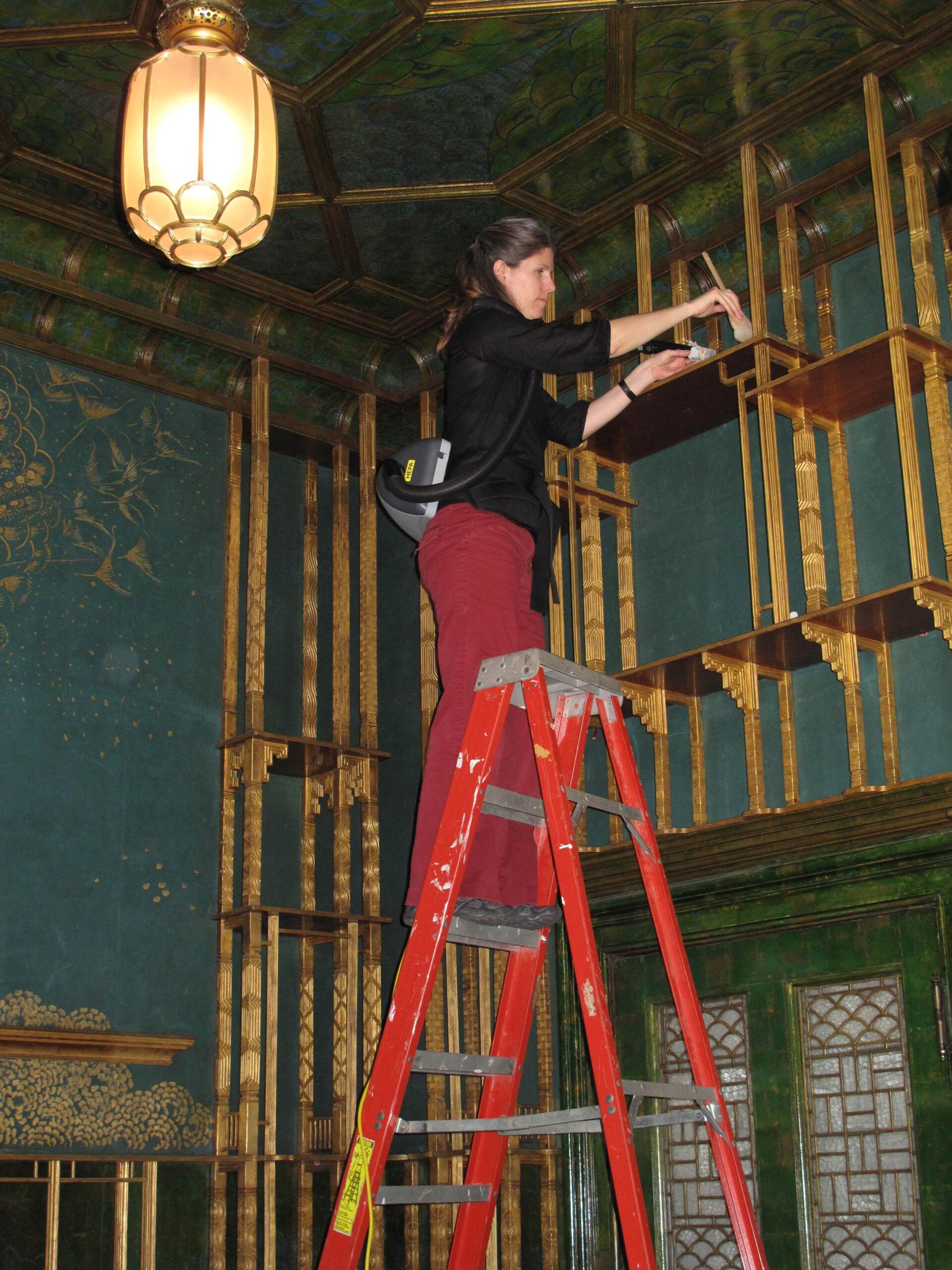Currently undergoing conservation for the first time in thirty years, James McNeill Whistler’s masterpiece will reopen with a new installation of ceramics in September 2022. The project will be divided into two parts: the first phase will address the windows and floor vents, and the second will address the painted surfaces of the room. Check our website for monthly updates as the project progresses.
Created by Whistler from 1876 to 1877, Harmony in Blue and Gold: The Peacock Room was installed at the Freer Gallery of Art prior to the museum’s opening in 1923. Most of the painted surfaces visitors see today are original material, except for some areas immediately around the doors and windows. The windows, terrazzo floor, and decorative vent covers are original to the Freer building, a listed historic site.
The Peacock Room has a long history. It has been disassembled and moved from London to Detroit, and then finally to Washington, DC. While some level of restoration during each of these moves was likely made, it was only in the 1940s that a major restoration was first documented. Boston-based art restorers John and Richard Finlayson dismantled the room for a fourth time and constructed a wooden framework for the panels and shelves. Additionally, the Finlaysons cleaned some areas of the room and retouched a number of places, painting over the original surface and obscuring many details of Whistler’s work.
The overall condition of the room would not be addressed on a large scale again until the early 1990s, when a team of ten conservators and scientists performed in-depth scientific analysis and conservation treatment over a four-year period. The team examined Whistler’s methods of painting and identified areas that had been painted over during the 1940s restoration. While the structural work remained stable, the overpaint masked the original surface in certain areas and had darkened over time, eclipsing Whistler’s complex decoration of the room. The extensive analysis and treatment during this project brought to light significant artistic details that had been obscured by use, pollution, light exposure, environmental changes, and the earlier treatments.
Although the Peacock Room is maintained on a regular basis, as one of the museum’s most visited spaces, it has accrued its share of wear and tear since this last treatment. As part of the museum’s centennial, the new installation of ceramics in the Peacock Room will reflect the way Freer used the space. The period of time between installations gives us the opportunity to carry out the first large-scale conservation project in thirty years in order to help preserve Whistler’s masterpiece for the future.
Prior to beginning any treatment work for the current project, we carefully examined the room. While the conservation work performed in the 1990s remains stable and in good condition, some areas that weren’t treated at that time now require attention. For the first portion of the project, we will focus on the treatment of three sets of shutter exteriors, their associated windows and window surrounds, and four floor vent covers which were not addressed in the earlier treatment campaign.
The shutter exteriors facing the windows were painted to harmonize with the interior but are not original Whistler work and appear to have been painted over during previous restorations. The paint on the exterior of the shutters is flaking due to changes in temperature and relative humidity next to the windows, and those exteriors will be treated this summer.
In 2012 the museum began opening the window shutters once a month so that the room could be viewed in natural light. However, the windowsills and the shutters have both suffered damage from the shutters being opened and closed. These problems will be fixed during the project so that the shutters can safely be opened for visitors.
When the Freer was renovated in 2016, both a carpet and the wood floor were removed from the room. Most of the adhesive that held the wood floor in place was also removed at that time, but it remains on the decorative bronze floor vent covers in each corner. We will remove this remaining adhesive because the vent covers are historically important and original to the Freer building.
For the second portion of the project, we will focus mainly on the treatment of elements of the Peacock Room painted by Whistler: the walls, wainscoting, gilded shelving, doors, and the northwest door surround. These surfaces have become grimy from dust and air pollution, which commonly happens in urban environments. The room has been dusted top to bottom during several reinstallations, but it had not been possible to carry out any more in-depth cleaning since the last major conservation work. Now we will be able to clean off the grime and other accretions. We’ll also be able to repair the damage to areas on the wainscoting and around the door that has been caused by heavy visitation over the years. We performed preliminary cleaning tests and confirmed that a layer of grime had accumulated on the painted surfaces since the treatment thirty years ago, and we will use these tests as a guide for the upcoming work.
In addition to NMAA staff, a number of other conservators will be working with us on the project. Tune in to future posts to learn more about the team and the ongoing conservation process.







